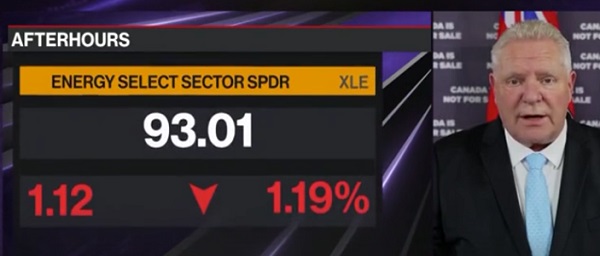Frontier Centre for Public Policy
Cowering before carbon

From the Frontier Centre for Public Policy
Despite turning this back this spring, South Dakota continues to be under attack by a freshly born green corporation, Summit Carbon Solutions, funded by China’s Belt and Road initiative, and you, through the Green New Deal provisions buried in the last debt ceiling deal, to pipe “carbon,” from the oil fields to some obscure part of the Dakotas and bury it. The “people” may “rise up” and demand it be shuttered, and all they do is crawl away and try again.
There can be no more stupid waste of money than this. But even some of our bravest politicians, including Kristi Noem, Pierre Poilivere and Danielle Smith in Canada cower before the almighty (anti-)carbon lobby and rabbit on about sequestering it. It is an industry into which thieves flood because it means you loot the public purse at the beginning through Green New Deal giveaways, and then for all perpetuity because of the tax advantage. People have been so scarified by the word, they do not know what it means anymore, they nod enthusiastically.
So let’s refresh: carbon = carbon dioxide. Plant food. Your outbreath. The thing that makes life on earth habitable. The thing they are trying to introduce into Mars to make it habitable. In order to terraform Mars, you need carbon dioxide.
A policy researcher friend tried to track down the annual billions, trillions over the last thirty years, that the U.N. and its various satellites have given of your money to “climate change” mitigation outfits in the Global South. The money vanishes, nothing happens, it’s stolen. She google-earthed one heavily PR’ed outfit, only to discover that it didn’t exist, just a pile of sand. These projects are payoffs to an army of activists placed at every weak point in the system. If the projects exist, they don’t work. Both the Guardian and Harper’s have done extensive work on the fraud of “climate mitigation.” Carbon sequestration is a scam meant to steal public money.
Yeah, this oughta work.
This time, Kristi Noem is facing down an activated people who are fit to be tied, protesting and signing petitions. This is generally taken as “the people’s voice” in the enviro business and must be obeyed. But not, apparently, when you are fighting “green.” This time, Summit Corporation is barreling through people’s farms, breaking into their barns, threatening ranchers with armed guards, and generally behaving like the WEFer army Trudeau sent to brutalize the truckers. This is a new iteration from the One World Government, anonymous Kevlar-coated mercenaries in the heartland.
So it is that the carbon dioxide pipeline in North Dakota is receiving rapid approvals and aggressive eminent domain clearing overturning the years, even decades it takes to clear a pipeline. The first thing Biden did was cancel the Keystone XL pipeline. It was protested by the activist army that moves into any hot spot, the leaders of which are paid well to lead the chaos. But in this instance, the carbon pipeline is being protested by actual residents fearing actual harm. Co2 is an unstable gas, unlike oil and natural gas. Co2 pipelines explode and kill people. They blow up in part because the technology is not sorted out, unlike petroleum engineering. But never mind! It’s virtuous. It’s fabulous, it must be done, whether you like it or not.
I know! Let’s overturn democracy. Writes Pipeline contributor Steven F. Hayward in the Claremont Review of Books:
The most overwrought, assertive climate change activists have a “transformative” agenda to halt and reverse global warming. The problem is that there’s no evidence voting majorities in any modern democracy are willing to be transformed by Green New Deals or other, even wilder schemes. And if the people reject the climate agenda? There must be ways to enact it despite them. There may even be ways to insist that this thwarting of the popular will is, in fact, a more noble rendering of democracy than mere government by consent of the governed.
He quotes Ross Mittiga, the author of “Political Legitimacy, Authoritarianism, and Climate Change,” asking whether we must sacrifice democracy to save the planet:
Satisfying this standard may entail elevating the status or power of experts in the political process by, for instance, affording them a salient consultatory role or even some kind of veto power over legislation…. One can imagine a “Supreme Court of Climate Experts,” tasked with evaluating, modifying, or striking down legislation to the extent it exacerbates the climate crisis or contributes to other grave forms of environmental destruction.
Observes Steve: “This hardly differs from the parade of authoritarian horrors offered elsewhere in the article.”
Oops.
Alas, all over the U.S., activists are attempting to override both political and judicial process placing their judgment above democratic process, and their pet judges agree. Usually local farmers, ranchers, rural businessmen and women are rolled flat by out-of-state lawyers and money from movie stars, but this time, the victims have constitutional lawyers. The South Dakota Freedom Caucus is fighting back and Gov. Noem is caught. Approving this pipeline will mean money for her coffers from Summit, jobs, albeit temporary; no doubt, federal funds will be held back until she approves it. You can read the Caucus’ extensive legal argument here.
Even the Sierra Club thinks carbon capture is fraudulent:
The fact that the 45Q tax break for carbon capture and sequestration specifically states that enhanced oil recovery [EOR] counts as sequestration means that these companies could get paid twice for the same carbon— first, via the tax break for capturing and shipping it, and again when they sell it for EOR. “The bottom line,” says [Richard] Kuprewicz, “is if you’re trying to get CO2 in the atmosphere to reduce global warming, but you’ve created this huge market incentive to drive and generate more oil recovery, that may be in conflict with getting rid of CO2 in the atmosphere… We’re getting ahead of ourselves on pipelines,” he says. “For billions of dollars you can make smart people do incredibly stupid things.”
Carbon capture is a gold rush, the gold being public money. Exxon Mobil just bought a carbon capture company. Certainly it knows of the dangers and inefficacy, but such virtue signaling makes them look good. Summit Corporation is another dishonest outfit prospecting for free public money.
Opposition mounts. The South Dakota Public Utilities Commission has announced it will hold hearings on their pipeline in September. Three days ago, Daniel Horowitz of The Blaze asked why Noem was dragging her heels about calling a special session of the legislature to deal with the “carbon-capture” threat.
This problem has been festering for quite some time, it’s just that the governor thought she’d be able to quietly skate by enabling Summit Carbon Solutions and Navigator CO2 to do the dirty work while not overtly endorsing their project. Noem’s reluctance to call a session comes on the heels of her refusal to support the existing bill in the regular session. The governor is pretending like this issue is just beginning and that lawmakers need to send some new legislation for her to review. But she is very familiar with House Bill 1133, introduced by Rep. Karla Lems. There’s nothing to review; it’s a one-paragraph bill. It simply makes it clear that eminent domain can only be used for a pipeline that actually produces a public good, not merely captures carbon. Done.
Can’t we just box it and ship it?
In Illinois, through which carbon pipelines are planned to flow, a state senator has proposed a moratorium on carbon capture pipelines to address safety concerns.
McClure said the pipeline issue was first brought to his attention by some of those who live along the path of Heartland Greenway. He said he was concerned about the potential for a pipeline rupture similar to one that happened in Satartia, Mississippi in early 2020, when 45 people were hospitalized and 200 were evacuated. The carbon dioxide sucked the air out of the surrounding area and caused gas-using vehicles to fail, according to reports.
“When you have a pipeline that’s that big [and] that will stretch across so much rural area, how on earth would emergency folks be able to get to a rupture in time to help people?,” McClure said.
We have to stop throwing our future into the great green maw.
Elizabeth Nickson is a Senior Fellow at the Frontier Centre for Public Policy. Follow her on Substack here.
Education
Our Kids Are Struggling To Read. Phonics Is The Easy Fix

From the Frontier Centre for Public Policy
One Manitoba school division is proving phonics works
If students don’t learn how to read in school, not much else that happens there is going to matter.
This might be a harsh way of putting it, but it’s the truth. Being unable to read makes it nearly impossible to function in society. Reading is foundational to everything, even mathematics.
That’s why Canadians across the country should be paying attention to what’s happening in Manitoba’s Evergreen School Division. Located in the Interlake region, including communities like Gimli, Arborg and Winnipeg Beach, Evergreen has completely overhauled its approach to reading instruction—and the early results are promising.
Instead of continuing with costly and ineffective methods like Reading Recovery and balanced literacy, Evergreen has adopted a structured literacy approach, putting phonics back at the centre of reading instruction.
Direct and explicit phonics instruction teaches students how to sound out the letters in words. Rather than guessing words from pictures or context, children are taught to decode the language itself. It’s simple, evidence-based, and long overdue.
In just one year, Evergreen schools saw measurable gains. A research firm evaluating the program found that five per cent more kindergarten to Grade 6 students were reading at grade level than the previous year. For a single year of change, that’s a significant improvement.
This should not be surprising. The science behind phonics instruction has been clear for decades. In the 1960s, Dr. Jeanne Chall, director of the Harvard Reading Laboratory, conducted extensive research into reading methods and concluded that systematic phonics instruction produces the strongest results.
Today, this evidence-based method is often referred to as the “science of reading” because the evidence overwhelmingly supports its effectiveness. While debates continue in many areas of education, this one is largely settled. Students need to be explicitly taught how to read using phonics—and the earlier, the better.
Yet Evergreen stands nearly alone. Manitoba’s Department of Education does not mandate phonics in its public schools. In fact, it largely avoids taking a stance on the issue at all. This silence is a disservice to students—and it’s a missed opportunity for genuine reform.
At the recent Manitoba School Boards Association convention, Evergreen trustees succeeded in passing an emergency motion calling on the association to lobby education faculties to ensure that new teachers are trained in systematic phonics instruction. It’s a critical first step—and one that should be replicated in every province.
It’s a travesty that the most effective reading method isn’t even taught in many teacher education programs. If new teachers aren’t trained in phonics, they’ll struggle to teach their students how to read—and the cycle of failure will continue.
Imagine what could happen if every province implemented structured literacy from the start of Grade 1. Students would become strong readers earlier, be better equipped for all other subjects, and experience greater success throughout school. Early literacy is a foundation for lifelong learning.
Evergreen School Division deserves credit for following the evidence and prioritizing real results over educational trends. But it shouldn’t be alone in this.
If provinces across Canada want to raise literacy rates and give every child a fair shot at academic success, they need to follow Evergreen’s lead—and they need to do it now.
All students deserve to learn how to read.
Michael Zwaagstra is a public high school teacher and a senior fellow at the Frontier Centre for Public Policy.
Economy
Support For National Pipelines And LNG Projects Gain Momentum, Even In Quebec

From the Frontier Centre for Public Policy
Public opinion on pipelines has shifted. Will Ottawa seize the moment for energy security or let politics stall progress?
The ongoing threats posed by U.S. tariffs on the Canadian economy have caused many Canadians to reconsider the need for national oil pipelines and other major resource projects.
The United States is Canada’s most significant trading partner, and the two countries have enjoyed over a century of peaceful commerce and good relations. However, the onset of tariffs and increasingly hostile rhetoric has made Canadians realize they should not be taking these good relations for granted.
Traditional opposition to energy development has given way to a renewed focus on energy security and domestic self-reliance. Over the last decade, Canadian energy producers have sought to build pipelines to move oil from landlocked Alberta to tidewater, aiming to reduce reliance on U.S. markets and expand exports internationally. Canada’s dependence on the U.S. for energy exports has long affected the prices it can obtain.
One province where this shift is becoming evident is Quebec. Historically, Quebec politicians and environmental interests have vehemently opposed oil and gas development. With an abundance of hydroelectric power, imported oil and gas, and little fossil fuel production, the province has had fewer economic incentives to support the industry.
However, recent polling suggests attitudes are changing. A SOM-La Presse poll from late February found that about 60 per cent of Quebec residents support reviving the Energy East pipeline project, while 61 per cent favour restarting the GNL Quebec natural gas pipeline project, a proposed LNG facility near Saguenay that would export liquefied natural gas to global markets. While support for these projects remains stronger in other parts of the country, this represents a substantial shift in Quebec.
Yet, despite this change, Quebec politicians at both the provincial and federal levels remain out of step with public opinion. The Montreal Economic Institute, a non-partisan think tank, has documented this disconnect for years. There are two key reasons for it: Quebec politicians tend to reflect the perspectives of a Montreal-based Laurentian elite rather than broader provincial sentiment, and entrenched interests such as Hydro-Québec benefit from limiting competition under the guise of environmental concerns.
Not only have Quebec politicians misrepresented public opinion, but they have also claimed to speak for the entire province on energy issues. Premier François Legault and Bloc Québécois Leader Yves-François Blanchet have argued that pipeline projects lack “social licence” from Quebecers.
However, the reality is that the federal government does not need any special license to build oil and gas infrastructure that crosses provincial borders. Under the Constitution, only the federal Parliament has jurisdiction over national pipeline and energy projects.
Despite this authority, no federal government has been willing to impose such a project on a province. Quebec’s history of resisting federal intervention makes this a politically delicate issue. There is also a broader electoral consideration: while it is possible to form a federal government without winning Quebec, its many seats make it a crucial battleground. In a bilingual country, a government that claims to speak for all Canadians benefits from having a presence in Quebec.
Ottawa could impose a national pipeline, but it doesn’t have to. New polling data from Quebec and across Canada suggest Canadians increasingly support projects that enhance energy security and reduce reliance on the United States. The federal government needs to stop speaking only to politicians—especially in Quebec—and take its case directly to the people.
With a federal election on the horizon, politicians of all parties should put national pipelines and natural gas projects on the ballot.
Joseph Quesnel is a senior research fellow with the Frontier Centre for Public Policy.
-

 2025 Federal Election1 day ago
2025 Federal Election1 day agoCanada Continues to Miss LNG Opportunities: Why the World Needs Our LNG – and We’re Not Ready
-

 International6 hours ago
International6 hours agoGermany launches first permanent foreign troop deployment since WW2
-

 COVID-192 days ago
COVID-192 days agoTrump’s new NIH head fires top Fauci allies and COVID shot promoters, including Fauci’s wife
-

 Freedom Convoy2 days ago
Freedom Convoy2 days agoFreedom Convoy leaders Tamara Lich, Chris Barber found guilty of mischief
-

 2025 Federal Election24 hours ago
2025 Federal Election24 hours agoMainstream Media Election Coverage: If the Election Was a NHL Game, the Ice Would be Constantly Tilted Up and to the Left
-

 2025 Federal Election10 hours ago
2025 Federal Election10 hours agoPoilievre To Create ‘Canada First’ National Energy Corridor
-

 Business2 days ago
Business2 days ago‘Time To Make The Patient Better’: JD Vance Says ‘Big Transition’ Coming To American Economic Policy
-

 2025 Federal Election2 days ago
2025 Federal Election2 days agoPoilievre promises to drop ‘radical political ideologies’ in universities






